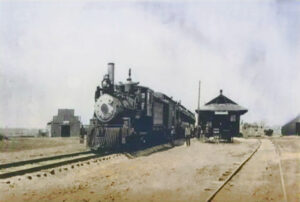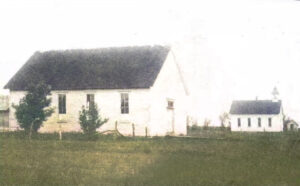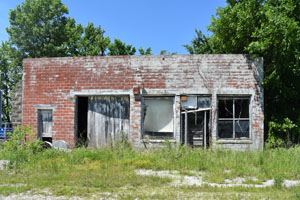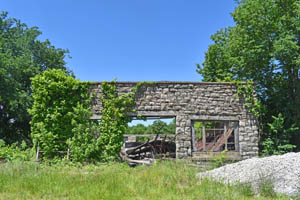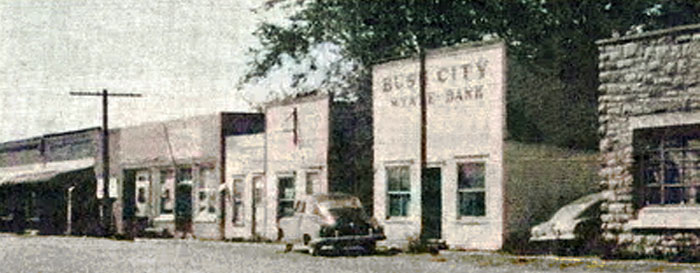
Vintage Bush City, Kansas.
Bush City, Kansas, is an unincorporated community in Lincoln township of Anderson County. It is also an extinct town as it no longer has a post office.
On April 5, 1880, a post office called Haskell was established and named in honor of Dudley C. Haskell, a Republican representative to the United States Congress. Located along the mail route from Garnett to Mound City, the post office was kept in the farm home of M.B. Clark, two and one-half miles east of the present site of Bush City, and he became the first postmaster.
The Methodist Church’s first meeting was held on November 6, 1883, in the home of C.G. Rebstock. The Lincoln Chapel Methodist Church, established in 1884, was located two miles east and two miles north of Bush City.
Haskell was filed as a townsite in March 1887, but no improvements or attempts were made to establish a town at this site.
In 1886, the Kansas, Nebraska, and Dakota Railroad started in Topeka and went to Fort Scott. The railroad entered Anderson County in the northwest corner and went to the first town of Amiot through Harris, Glenloch, Garnett, Bush City, and Selma. It left the county east of Selma and went to Fort Scott. Politicians living along the railroad could go to Topeka in the morning and return home in the evening.
A town was platted in 1887 on land owned by Colonel L.L. Bush of Philadelphia, Pennsylvania, who had initially purchased the property from Mr. Snyder. Colonel Bush was the primary promoter of the Kansas, Nebraska, and Dakota Railroad. The depot was named Bush City after Colonel Bush. However, the post office name remained Haskell.
Property was sold in Bush City in July 1887, with lots offered for $10 to $75 per lot. When Colonel Bush donated the land for the town, he stipulated that it have a school, the first of which was located on the Chris Rebstock farm, one-half mile north of town. Later, the Rebstock School House was moved to the northwest side of town. About two years later, the old school was moved across the street and made into a barn, and Will Cook built a new wood-frame school.
John Mulford built the first store building, and Robert Kincaid of Kincaid opened the first general merchandise store in this building, with Van Sharp operating the store. Olds and Comine soon also had a general merchandise store. At that time, there was also a blacksmith shop, a livery stable, a church, and a school.
The First Baptist Church was organized in June 1889. It was first located in Minkler School, two miles south of Bush City.
The First Baptist Church was moved to Bush City into a new building completed in 1894.
The oil industry in Anderson County began in 1904 when a good gas well was drilled northeast of Garnett.
In October 1908, the Methodist Church was struck by lightning and burned down. By May 1, 1909, the church had moved into a new building.
In 1910, Haskell was a station on the Missouri Pacific Railroad. At that time, it had telegraph and express offices, a money order post office, and a population of 75.
A larger two-story brick school was erected in 1913. The new building had two rooms downstairs, two rooms upstairs, and an auditorium with a stage. The old wooden frame building was then moved downtown and used as a garage.
Olds and Comine organized the Bush City Bank on April 26, 1916.
In the 1920s, John C. Keyes and Joe Kleckner opened the Bush City Oil Field. The first well was on the Ware Lease one mile north and three miles west of Bush City. Land began to be leased to drill wells at one dollar per acre. This oil field extended northeast of Bush City into Linn County.
The post office’s name was changed to Bush City on April 19, 1921, because mail designated for the Haskell post office was often confused with the mail for the Haskell Indian School in Lawrence, Kansas.
In 1923, “oil fever” hit Lincoln Township. Underneath were “shoestring sands,” or long strips of sand lying beneath the earth’s surface instead of a solid bed of sand. These sands were saturated with oil and gas.
From 1923 to 1928, Bush City was a boom town. The population more than doubled, and housing was at a premium. Oil rigs were constantly being moved through and by Bush City. They were very cumbersome, and it took 6 to 16 teams to pull them.
Enough oil was being produced, and an oil refinery was located on the Ewing Lease north of Bush City. Anyone could stop and buy gasoline for seven cents a gallon. Some fascinating people would stop to buy fuel for their vehicles. Two such people were famous bank robbers, Pretty Boy Floyd and John Dillinger. They did not hesitate to let people know who they were, and with their names went a warning not to let people know they were by the station. They bought gas there when taking the back roads between Kansas City and Oklahoma.
When the Kansas, Nebraska, and Dakota Railroad tracks were removed in 1934, railroad property was sold. The old Bush City Depot was moved one mile south and one-half mile west to become a private home.
The Methodist Church was torn down in 1945.
Following World War II, school consolidation began, smaller schools in the area were closed, and children came to Bush City. This became District #50.
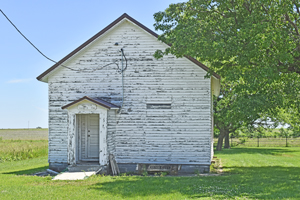
The old community building in Bush City, Kansas, looks as if it could be the church building post above.
In 1955, the brick school was condemned, and a new modern building was constructed. Later, the old school was torn down, and the bricks were used to build a new home east of Bush City.
The lower and upper grades were divided between the two rooms in the new school until the 1960s.
In 1962, District #50 was unified with District #365, at which time, seventh and eighth-grade students were bussed to Garnett for Junior High.
Bush City’s post office closed on February 29, 1956.
The Bush City Elementary School closed in 1964 and sold in 1974. Today, it is a private residence.
The Goppert Bank chain bought the controlling interest in the Bush City Bank in 1963. In 1974, the bank moved to Colony, Kansas.
The last general store in Bush City closed in 1975.
The First Baptist Church closed in April 1981.
Today, very little is left in Bush City. However, it still has named streets, a few old business buildings, a community building that appears to have been a church, and a few homes.
Bush City is ten miles southeast of Garnett, the county seat.
© Kathy Alexander/Legends of Kansas, October 2024.
Also See:
Extinct Towns of Anderson County
Sources:
Anderson County Historical Society
Blackmar, Frank W.; Kansas: A Cyclopedia of State History, Vol I; Standard Publishing Company, Chicago, IL 1912.
Cutler, William G; History of Kansas; A. T. Andreas, Chicago, IL, 1883.
Wikipedia

